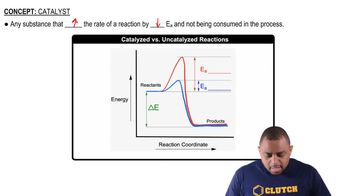Here are the essential concepts you must grasp in order to answer the question correctly.
Catalysis
Catalysis is the process by which the rate of a chemical reaction is increased by a substance called a catalyst. Catalysts work by providing an alternative reaction pathway with a lower activation energy, allowing the reaction to proceed more quickly. In this case, NO2 acts as a catalyst in the oxidation of SO2 to SO3, facilitating the reaction without being consumed in the process.
Recommended video:
Catalyzed vs. Uncatalyzed Reactions
Reaction Stoichiometry
Reaction stoichiometry involves the quantitative relationships between reactants and products in a chemical reaction. It is essential to balance chemical equations to ensure that the number of atoms for each element is conserved. In the given question, determining the appropriate coefficients for the reactions allows for the correct summation of the individual reactions to represent the overall process of SO2 oxidation.
Recommended video:
Homogeneous vs. Heterogeneous Catalysis
Homogeneous catalysis occurs when the catalyst and the reactants are in the same phase, typically in a solution, while heterogeneous catalysis involves a catalyst in a different phase than the reactants, often solid catalysts with gaseous or liquid reactants. In the provided reaction, since NO2 and SO2 are both gases, this is an example of homogeneous catalysis, as all species involved are in the same phase.
Recommended video:
Catalyzed vs. Uncatalyzed Reactions
 Verified step by step guidance
Verified step by step guidance

